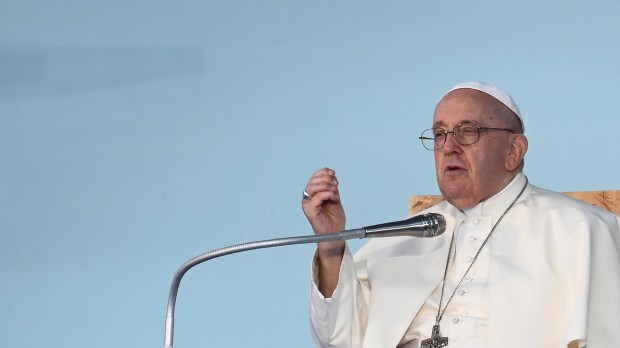From September 1 to October 4, the Catholic Church and other Christian Churches and communities are celebrating the Season of Creation, a period of prayer and reflection as stewards of God’s creation. At the end of this period Pope Francis will publish a text in continuation with his 2015 encyclical, Laudato Si’, on the care for creation and integral ecology. But what is integral ecology and what place does it have within Catholic thought?
The University of Oxford’s Campion Hall, a Jesuit institution within the establishment, defines integral ecology as “the interconnectedness between humans and the natural world,” which “touches every aspect of human life, from political and economic to cultural, social, and theological.”
The need to care for our common home and the understanding that human lives are interconnected with the environment that God has given us predates Pope Francis’ papacy.
Here we review how various popes have characterized human development and the care for the environment, and how this tradition has led to Pope Francis’ integral ecology, as described in Laudato Si’.
The origins: Leo XIII’s 1891 encyclical, Rerum Novarum
In Laudato Si’, Pope Francis says he hopes the encyclical will be a contribution to the Church’s body on Catholic social teaching, which is concerned with human development and dignity, and building a just and good society for all. In fact Pope Francis’ text closely links this body of thought with the need to care for creation, since to create a society adequate for humanity, the environment must be taken into account.
Thus it is only natural to look for the origins of Laudato Si’ in a foundational text of Catholic social teaching: Pope Leo XIII’s (pontificate from 1878-1903) encyclical Rerum Novarum (“Of New Realities”). Published in 1891, this text addressed and called for the respect of the rights and conditions of workers, especially in light of the Industrial Revolution. Although not directly concerned with the environment, in this papal document there were already some ideas about the interconnectedness between our environment and human life, with an emphasis on the common good.
In defending the right to private property, Leo XIII acknowledged humanity’s shared responsibility to take care of the earth. “The earth, even though apportioned among private owners, ceases not thereby to minister to the needs of all, inasmuch as there is not one who does not sustain life from what the land produces,” the 19th-century Pope wrote. Additionally he stated that whoever received “from the divine bounty a large share of temporal blessings,” whether it be resources, private property, or a “gift of the mind,” should use them for himself but also “for the benefit of others” as a “steward of God’ providence.”
Future popes developed these ideas
Other popes, such as Pius XI (pope from 1922-1939) or John XXIII (pope from 1958-1963), then developed and built on these ideas of human dignity concerning the interconnectedness of the global economic systems and the role that states, individuals, and workers play.
However, Pope Paul VI (1963-1978) was likely one of the first pontiffs to acknowledge directly human responsibility in the degradation of the environment. He mentioned this in a 1970 speech for the 25th anniversary of the UN’s Food and Agriculture Organization, and then included this idea in his encyclical Octogesima Adveniens (1971), published on occasion of the 80th anniversary of Rerum Novarum. “Man is suddenly becoming aware that by an ill-considered exploitation of nature he risks destroying it and becoming in his turn the victim of this degradation,” he said, over half a century ago. The “dramatic and unexpected consequence of human activity” is “an environment for tomorrow which may well be intolerable,” he explained.
“The Christian must turn to these new perceptions in order to take on responsibility, together with the rest of men, for a destiny which from now on is shared by all.”
Ecology in its different forms: Human, social, natural
John Paul II (1978-2005) then developed this idea by not only condemning the destruction of the environment but also recognizing the importance of safeguarding the “human” part of ecology. “Not only has God given the earth to man, who must use it with respect for the original good purpose for which it was given to him, but man too is God’s gift to man. He must therefore respect the natural and moral structure with which he has been endowed,” he explained in his encyclical Centesimus Annus, published on the 100th anniversary of Rerum Novarum. Ecology and its interaction with human dignity and life was a present topic in various of his writings.
Benedict XVI (pope from 2005 to 2013), nicknamed the Green Pope, also spoke about ecology often in his interventions, and like John Paul II acknowledged the different aspects of society that relate to creation. For example in his messages for the World Day for Peace in 2007 and 2010 he stressed that to achieve peace, society needed to acknowledge the links between human and environmental ecology.
“The Church has a responsibility towards creation and she must assert this responsibility in the public sphere. In so doing, she must defend not only earth, water, and air as gifts of creation that belong to everyone. She must above all protect mankind from self-destruction,” he wrote in his encyclical Caritas in Veritate in 2009. “The deterioration of nature is in fact closely connected to the culture that shapes human coexistence:when ‘human ecology’ is respected within society, environmental ecology also benefits.”
Pope Francis’ integral ecology
Within the legacy of his predecessors, Pope Francis in Laudato Si’ highlighted the concept of integral ecology, basically emphasizing how all elements of society are interconnected with the environment and caring for creation. In Points 3 to 6 of his encyclical Pope Francis even highlights the main points of what his predecessors have said on the subject.
Then he dedicates Chapter 4 of the text to integral ecology and breaks it down into sub-themes that touch all aspects of human life: culture and history, economic and social systems, the body and gender, the relations between generations, the common good and more. This touches on several constant themes of his pontificate such as paying attention to the poor and most vulnerable in society, countering “throw-away culture,” and the power structures caused by technology.
“St. Francis helps us to see that an integral ecology calls for openness to categories which transcend the language of mathematics and biology, and take us to the heart of what it is to be human,” the Pope explains in his introduction. “Everything is closely interrelated, and today’s problems call for a vision capable of taking into account every aspect of the global crisis.”
“An integral ecology includes taking time to recover a serene harmony with creation, reflecting on our lifestyle and our ideals, and contemplating the Creator who lives among us and surrounds us, whose presence must not be contrived but found, uncovered,” the Pope says.


